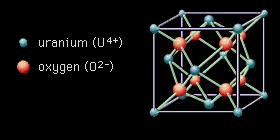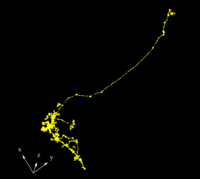TF PR UO2damage
User_talk:Foretony#Public_Relations
Uranium Oxide
Uranium Oxide is a common fuel used by nuclear reactors to generate electricity. Uranium releases energy when it splits into two ions, fission fragments, during a process known as fission. These ions are energetic enough to displace other Uranium and Oxygen atoms, causing damage the Uranium Oxide fuel, as the fission fragment ions traverse the fuel. As part of the Idaho National Lab's mission of ensuring safe sustainable energy, the lab conducts research to determine the effects of this damage on the safe use of the fuel. The image below illustrates a computer simulation by a physics graduate student of the damage done to uranium oxide by one such fission fragment, Xenon.
As the Xenon atom travels through the Uranium Oxide, Uranium and Oxygen atoms are removed from their stationary positions. These atoms can either end up in new positions within the material that were not originally positions held by atoms or replace previously knocked out atoms. These two conditions, referred to as interstitial and replacements are the two possibilities for the atoms after irradiation damage. The original atom positions can also remain empty, creating what are termed vacancies within the lattice. All three conditions are the main descriptions of how materials are damaged by atoms after such an event. My work has focused on building a new model using GEANT4 to update and improve on previous methods used to perform a Binary Collision Approximation.

